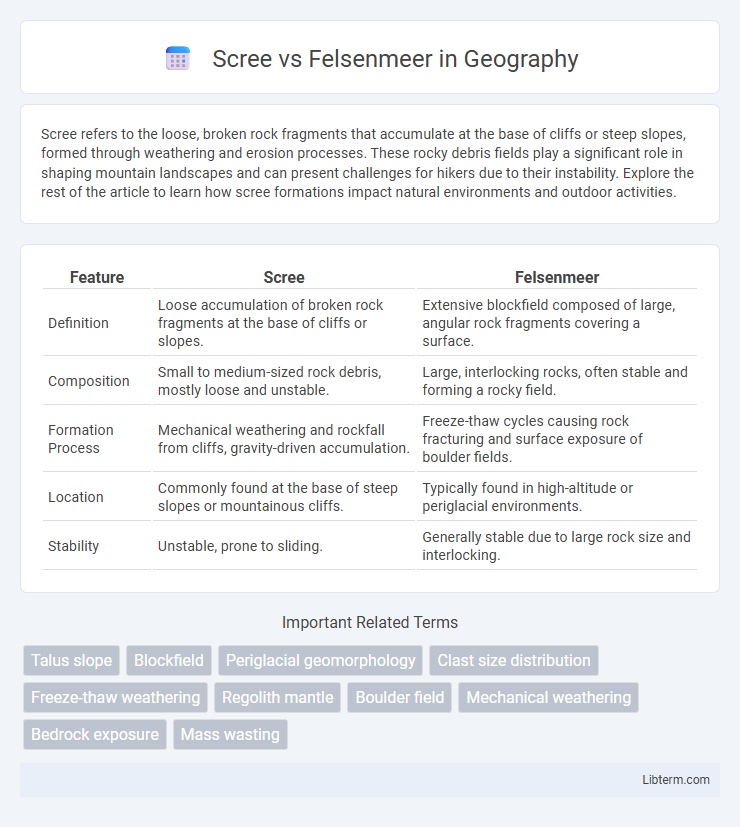Scree refers to the loose, broken rock fragments that accumulate at the base of cliffs or steep slopes, formed through weathering and erosion processes. These rocky debris fields play a significant role in shaping mountain landscapes and can present challenges for hikers due to their instability. Explore the rest of the article to learn how scree formations impact natural environments and outdoor activities.
Table of Comparison
| Feature | Scree | Felsenmeer |
|---|---|---|
| Definition | Loose accumulation of broken rock fragments at the base of cliffs or slopes. | Extensive blockfield composed of large, angular rock fragments covering a surface. |
| Composition | Small to medium-sized rock debris, mostly loose and unstable. | Large, interlocking rocks, often stable and forming a rocky field. |
| Formation Process | Mechanical weathering and rockfall from cliffs, gravity-driven accumulation. | Freeze-thaw cycles causing rock fracturing and surface exposure of boulder fields. |
| Location | Commonly found at the base of steep slopes or mountainous cliffs. | Typically found in high-altitude or periglacial environments. |
| Stability | Unstable, prone to sliding. | Generally stable due to large rock size and interlocking. |
Introduction to Scree and Felsenmeer
Scree consists of loose, broken rock fragments typically found at the base of cliffs or steep slopes, formed through physical weathering and gravitational movement. Felsenmeer, or rock sea, describes an extensive expanse of angular rock blocks covering the ground, often the result of frost weathering in cold climates. Both landforms are key indicators of geomorphological processes shaping mountainous and cold environment terrains.
Defining Scree: Characteristics and Formation
Scree consists of loose, broken rock fragments that accumulate at the base of cliffs or steep slopes, typically formed through physical weathering processes like freeze-thaw cycles. These angular rock debris pieces create unstable, shifting surfaces that contrast with the larger, more stable boulders found in felsenmeer. Scree slopes often develop in mountainous regions where repeated temperature fluctuations cause rock disintegration.
Understanding Felsenmeer: Origins and Features
Felsenmeer, a German term meaning "sea of rocks," refers to extensive fields of angular boulders typically formed by frost weathering in periglacial environments. Unlike scree, composed mainly of smaller, loose rock fragments accumulated at the base of cliffs through rockfall, Felsenmeer features larger, more stable rock blocks often found on slopes and hilltops. These formations originate from freeze-thaw cycles that fracture bedrock in situ, creating characteristic blockfields that influence local ecology and geomorphology.
Key Differences Between Scree and Felsenmeer
Scree consists of loose, fragmented rock debris that accumulates at the base of cliffs or steep slopes, typically formed by physical weathering processes like freeze-thaw cycles. Felsenmeer, also known as blockfield, features a surface covered by large, angular boulders formed in situ from bedrock through intense frost weathering, often creating a jumbled rock sea on flat or gently sloping ground. The key differences lie in their formation, with scree deposited by gravity at slope bases and felsenmeer representing a weathered rock layer remaining in place.
Geological Processes Involved
Scree and Felsenmeer represent different geomorphological features formed by rock weathering and mass-wasting processes. Scree, also known as talus, consists of loose, angular rock fragments accumulating at the base of cliffs due to frost wedging and gravity-driven rockfall. Felsenmeer, or blockfields, are extensive surface pavements of large, angular rock blocks primarily shaped by periglacial freeze-thaw cycles and minimal transport, reflecting in-situ weathering and cryogenic disintegration.
Environmental and Climatic Influences
Scree and Felsenmeer formations result from distinct environmental and climatic influences that shape their development; scree slopes typically form in colder, alpine regions through freeze-thaw weathering, where temperature fluctuations cause rock fragmentation. Felsenmeer, often found in periglacial environments, develops from prolonged frost action that breaks bedrock into angular blocks, creating extensive blockfields. Both features reflect the interplay of temperature extremes, moisture availability, and geological substrate, which determine fragment size, stability, and landscape distribution.
Ecological Impacts of Scree and Felsenmeer
Scree and Felsenmeer environments support distinct ecological communities due to their differing substrate stability and moisture retention, with scree slopes favoring pioneer plants adapted to unstable, coarse debris and fast drainage. Felsenmeer, characterized by extensive, blocky rock fields, provides more stable habitats that harbor specialized mosses, lichens, and invertebrates adapted to microhabitats within crevices. Both landforms contribute to biodiversity by creating niche environments, yet scree's dynamic nature often results in frequent disturbance that limits long-term vegetation succession compared to the relatively stable Felsenmeer ecosystems.
Distribution and Notable Locations Worldwide
Scree and Felsenmeer are both types of rock debris, with scree primarily found on steep mountain slopes worldwide, such as the European Alps, the Rocky Mountains, and the Himalayas. Felsenmeer, characterized by its extensive, densely packed boulder fields, is notably present in regions like the Harz Mountains in Germany and the Ardennes in Belgium. These formations occur due to freeze-thaw weathering in cold climates, leading to their distinct spatial distribution across temperate, alpine, and polar environments.
Importance in Geomorphology and Geology
Scree and Felsenmeer represent distinct geomorphological features critical for understanding slope processes and rock weathering patterns in mountainous regions. Scree consists of loose, angular rock debris accumulated at the base of cliffs, reflecting mechanical frost weathering and gravity-driven mass wasting events, while Felsenmeer describes a surface of closely packed, angular boulders formed by repeated freeze-thaw cycles indicating intense periglacial conditions. Their study provides valuable insights into landscape evolution, rock weathering rates, and climatic influences on mountain stability and sediment transport.
Conclusion: Scree vs Felsenmeer in Landscape Evolution
Scree and Felsenmeer represent distinct yet interconnected geomorphological features shaping mountainous landscapes. Scree consists of loose, angular rock fragments accumulated at the base of cliffs due to physical weathering and gravity, facilitating slope stabilization and gradual soil formation. Felsenmeer, characterized by extensive surface rock blocks resulting from frost weathering, influences landscape evolution by modulating erosion patterns and providing a persistent caprock layer that affects hydrology and vegetation distribution.
Scree Infographic

 libterm.com
libterm.com